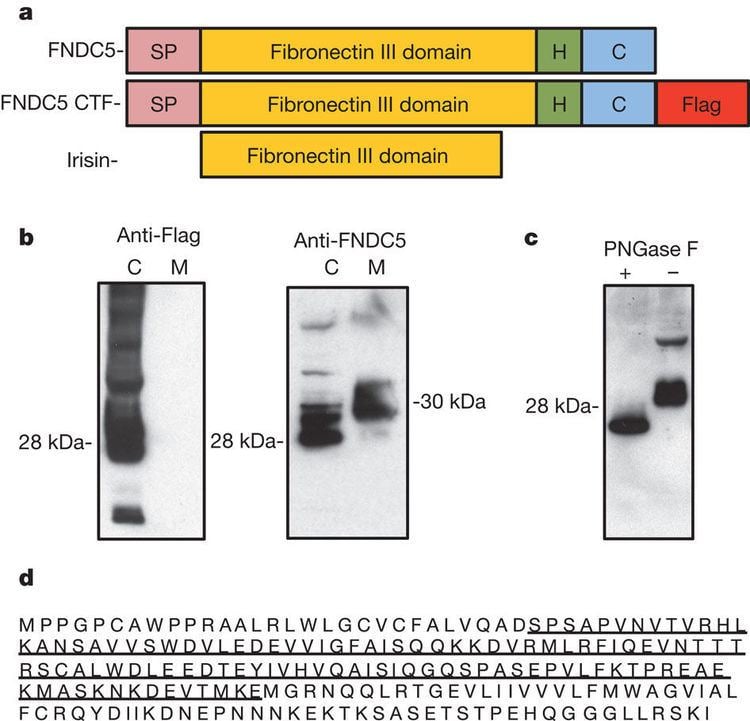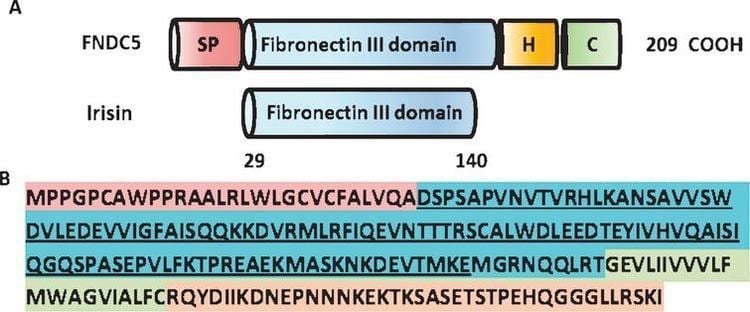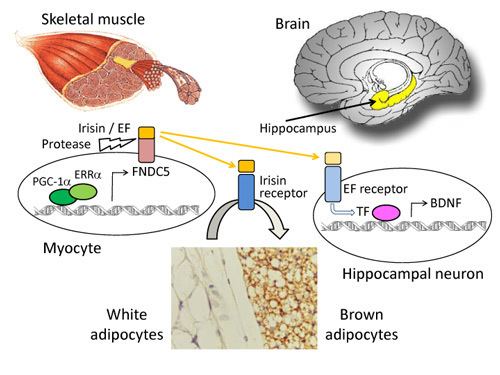Entrez 252995 | Ensembl ENSG00000160097 | |
 | ||
External IDs MGI: 1917614 HomoloGene: 17812 GeneCards: FNDC5 | ||
Gene music using protein sequence of fndc5 fibronectin type iii domain containing 5
Fibronectin type III domain-containing protein 5, the precursor of irisin, is a protein that is encoded by the FNDC5 gene. Irisin is a cleaved version of FNDC5, named after the Greek messenger goddess Iris.
Contents
- Gene music using protein sequence of fndc5 fibronectin type iii domain containing 5
- History
- Biosynthesis and secretion
- Function
- References

Fibronectin domain-containing protein 5 is a membrane protein comprising a short cytoplasmic domain, a transmembrane segment, and an ectodomain consisting of a ~100 kDa fibronectin type III (FNIII) domain.

History

FNDC5 was discovered during a genome search for fibronectin type III domains and independently in a search for peroxisomal proteins.

The ectodomain was proposed to be cleaved to give a soluble peptide hormone named irisin. Separately it was proposed that irisin is secreted from muscle in response to exercise, and may mediate some beneficial effects of exercise in humans and the potential for generating weight loss and blocking diabetes has been suggested. Others questioned these findings.
Biosynthesis and secretion
The FNDC5 gene encodes a prohormone, a single-pass type I membrane protein (human, 212 amino acids; mouse and rat, 209 amino acids) that is upregulated by muscular exercise and undergoes post-translational processing to generate irisin. The sequence of the protein includes a signal peptide, a single fibronectin type III domain, and a C-terminal hydrophobic domain that is anchored in the cell membrane.
The production of irisin is similar to the shedding and release of other hormones and hormone-like polypeptides, such as epidermal growth factor and TGF alpha, from transmembrane precursors. After the N-terminal signal peptide is removed, the peptide is proteolytically cleaved from the C-terminal moiety, glycosylated and released as a hormone of 112 amino acids (in human, amino acids 32-143 of the full-length protein; in mouse and rat, amino acids 29-140) that comprises most of the FNIII repeat region.
The sequence of irisin, the cleaved and secreted portion of FNDC5, is highly conserved in mammals; the human and murine sequences are identical. However, the start codon of human FNDC5 is mutated to ATA, which causes it to be expressed at only 1% the level of other animals with the normal ATG start - though its circulation levels are still on par with other key humanhormones, such as insulin.
A difference in the nucleotide sequence of human FNDC5 from that of mouse Fndc5 creates a different initiation codon, potentially generating a protein that begins at methionine-76 (Met-76). A protein initiated at Met-76 would be missing the signal peptide and would be trapped in the cytoplasm. Via mass spectrometry, irisin has been found to circulate in humans in levels similar to other key hormones, such as insulin.
Function
Exercise causes increased expression in muscle of peroxisome proliferator-activated receptor gamma coactivator 1 alpha (PGC-1alpha), which is involved in adaptation to exercise. In mice, this causes production of the FNDC5 protein which is cleaved to give a new product irisin. Due to its production through a mechanism initiated by muscular contraction, irisin has been classified as a myokine.
Based on the findings that FNDC5 induces thermogenin expression in fat cells, overexpression of FNDC5 in the liver of mice prevents diet-induced weight gain, and FNDC5 mRNA levels are elevated in human muscle samples after exercise, it has been proposed that irisin promotes the conversion of white fat to brown fat in humans which would make it a health promoting hormone. However this proposal has been challenged because FNDC5 is upregulated only in highly active elderly humans.
A 2016 in vitro study of white and brown fat cell tissue found dose-related upregulation of a protein called UCP1 that contributes to the browning of white fat and found other markers that would indicate that the white cells were browning and that fat cells were more metabolically active. Many of the stem cells became a type of cell that matures into bone. The tissue treated with irisin produced about 40 percent fewer mature fat cells.
In mice, irisin released from skeletal muscle during exercise acts directly on bone by increasing cortical bone mineral density, bone perimeter and polar moment of inertia.
